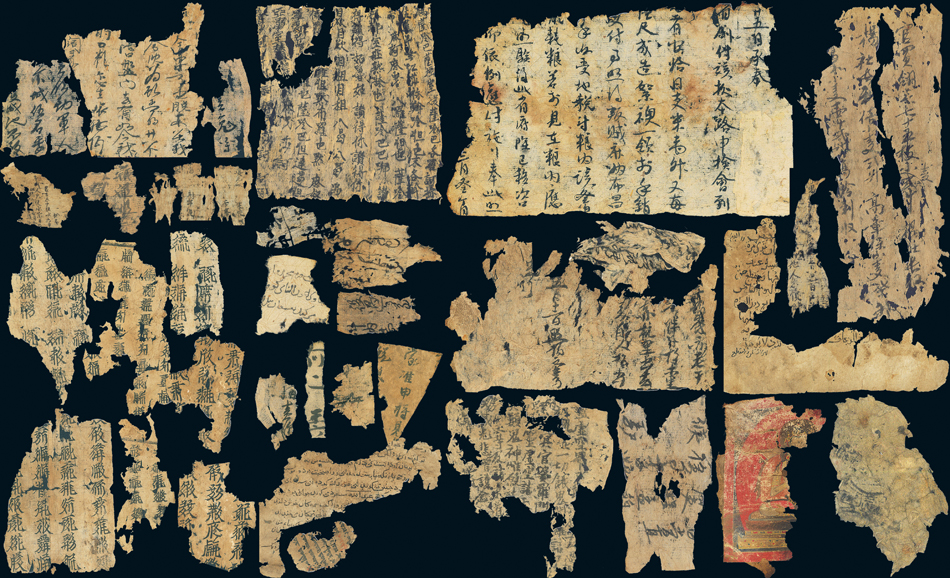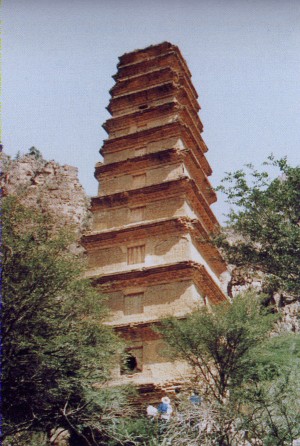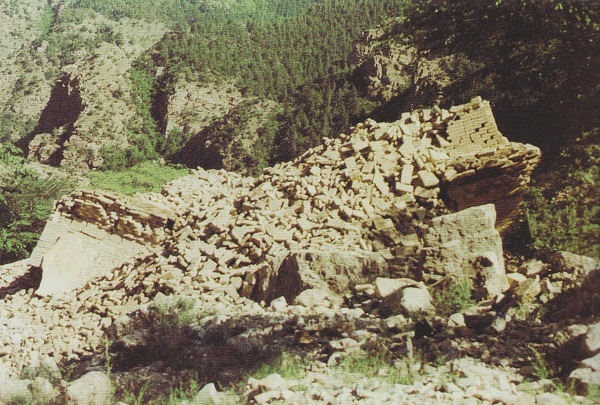BabelStone Blog
Monday, 3 August 2015
Tangut Texts for Sale
On 23 November 2014, at the Beijing Capital Library an auction of ancient documents was held by the Beijing Debao International Auction Co. (北京德宝2014年秋季古籍文献拍卖会). Among the 376 items under auction were nine lots consisting of Tangut manuscripts and printed texts, ranging from single sheets from manuscript or printed texts to a complete fascicle of a woodblock printed book. The sale of such a relatively large number of Tangut texts is unprecedented, and attracted a great deal of interest from buyers. Two of the Tangut lots (nos. 65 and 72) achieved the highest prices in the whole auction, and the nine lots sold for a total of ¥1,399,000 ($225,264).
| Lot No. | Image | Description | Price achieved |
|---|---|---|---|
| 64 | 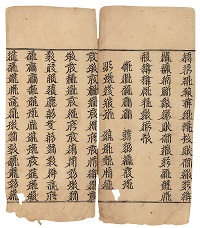 |
金刚般若波罗蜜经残页 / 西夏刻本 / 一沓 Number of sheets from a woodblock printed edition of the Tangut translation of the Vajracchedikā-prajñāpāramitā-sūtra. |
¥50,000 ($8,050) |
| 65 | 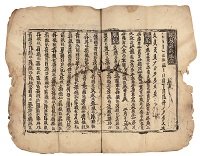 |
西夏文字字典 / 西夏刻蝴蝶装本 / 一册附一张 Woodblock printed edition of a Tangut dictionary, butterfly binding (1 fascicle [14 folios] and 1 loose sheet). |
¥690,000 ($111,102) |
| 66 | 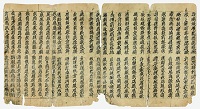 |
西夏文写本 / 西夏写本 / 一张 Sheet from a manuscript of a Tangut Buddhist text. |
¥8,000 ($1,288) |
| 67 | 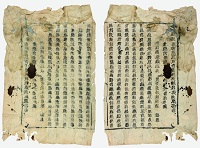 |
西夏文佛经 / 西夏活字印本 / 一张 Half a folio from a moveable wooden type printed edition of a Tangut Buddhist text. |
¥28,000 ($4,508) |
| 68 | 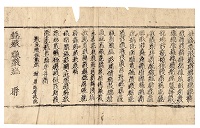 |
西夏文佛经 / 西夏刻本 / 一张 Final part of a woodblock printed scroll of a Tangut Buddhist sutra, printed on behalf of the crown prince. |
¥40,000 ($6,440) |
| 69 | 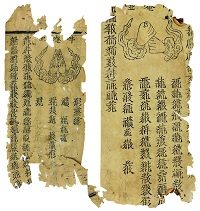 |
西夏文佛经 / 西夏刻本 / 二张 2 sheets from a woodblock printed edition of a Tangut Buddhist text showing mudras. |
¥8,000 ($1,288) |
| 70 | 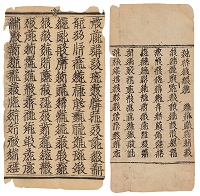 |
西夏文佛经 / 西夏刻本 / 一沓 Number of sheets from a woodblock printed edition of a Tangut Budhist sutra. |
¥90,000 ($14,491) |
| 71 | 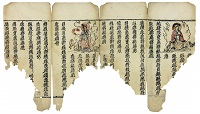 |
西夏文佛经 / 西夏刻手绘设色本 / 一沓 Number of sheets from a woodblock printed edition of a Tangut Buddhist sutra, with hand-coloured illustrations. |
¥95,000 ($15,296) |
| 72 | 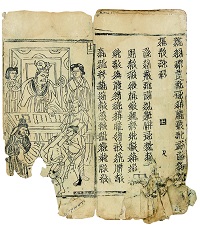 |
佛说父母恩咒经等二种 / 西夏刻本 / 一沓 Number of sheets from two woodblock printed editions of Tangut Buddhist texts, one an edition of the Sutra of Filial Piety, and one an illustrated edition of a text describing the judgement of the dead. |
¥390,000 ($62,796) |
Fake ?
Given the epidemic of fakes that has flooded the Chinese antiquities market over the last twenty years or so, it is reasonable to assume that any Tangut item for sale is a fake unless there is strong evidence to think otherwise. However, at first sight none of the nine Tangut lots in the 2014 auction are obviously fake. Although there are large numbers of fake Tangut coins on the market, and all sorts of dubious bronze and ceramic items with Tangut inscriptions can easily be found on Chinese auction sites, I have rarely seen a fake Tangut manuscript for sale, and I have never yet seen a fake woodblock printed Tangut text (I've looked and failed to find an example of a fake Tangut text to illustrate this blog post*). So, if these are fakes, they are very unusual.
* I have been shown two examples of fake Tangut texts by private correspondents (which I am unable to put in this post): one written on paper and pasted on antique wooden boards with painted Buddhist images; and one written on rolls of silk, with coloured drawings. Both are outlandish in form and amateurish in calligraphy, quite different from the Tangut items under discussion here. Significantly, they both comprise handwritten Tangut text, as it is an order of magnitude more difficult and time-consuming to produce fake woodblock printings than it is to to produce handwritten documents.
These are my brief initial impressions on the nine lots in the November 2014 auction :
- No. 64. This looks like a typical sutra manuscript on typical sutra paper, although it is not impossible that it is a very good modern copy.
- No. 65. This is woodblock printed edition of an unknown Tangut text, and would at first appearances seem to be beyond the skill of any modern faker to produce. Unlike the Buddhist texts, which could conceivably have been copied carefully and exactly from genuine manuscripts or xylographs by someone with only a little knowledge of Tangut language and script, this text is unique, with no known model for the content, and it would have taken someone with exceptional knowledge of Tangut writing (including Tangut cursive script) and Tangut language to produce it. Moreover, this item is not just one or two sheets, but is a complete fascicle of fourteen folios, so it would have taken considerably greater effort and time to write the text, carve the woodblocks and print the book than it would to produce a fake manuscript fragment. I have heard some comments privately that the paper and the ink do not seem right, but it is very hard to judge these from a photograph, and there is nothing about the physical appearance of the text that raises a red flag for me.
- No. 66. This looks like a typical sutra manuscript on typical sutra paper.
- No. 67. This is described as being printed from moveable wooden type, and the Tangut characters are unevenly aligned, unevenly sized, and unevenly inked, as if indeed printed from moveable type; but compared with known genuine Tangut wooden moveable type editions such as the Auspicious Tantra of All-Reaching Union these features are exaggerated, and it is either a poor quality genuine moveable type edition, or a not entirely successful modern attempt at moveable type printing. Fake Khitan wooden moveable type is not uncommon, so it is not implausible that someone has manufactured Tangut type matrices in order to fake printed Tangut texts, but on the other hand, the quality and appearance of this item is much better than any fake Khitan items I have seen.
- No. 68. This is a woodblock printed scroll, which is uncommon but not unknown (Kychanov's Catalogue of Tangut Buddhist Texts in the IOM lists seven examples: Nos. 108, 322, 382, 401, 402, 600, and 646). The quality of the printing is not very good, but that is not unusual.
- No. 69. This seems like a genuine woodblock printed text. The mudra illustrations look authentic, and the use of Chinese characters for the Sanskrit mantras above the mudras is plausible.
- No. 70. This item comprise sheets from at least two woodblock printed Buddhist texts, and appear genuine to me.
- No. 71. This is perhaps the most suspicious item. Its hand-coloured illustrations are unusual, and typical of the sort of extraordinary feature that fakers often produce in order to entice a high price. The strange greyish-white colour of the paper may also be an indicator of that it is a modern piece.
- No. 72. This lot consists of two illustrated woodblock printed texts. They appear genuine to me.
In summary, the texts appear to be plausible (No. 65 is unparalleled but far from implausible), with none of the amateurish mistakes and outlandish features that often mark out fakes. It is difficult to be certain about the physical aspects of the texts (paper and ink) without examining the items in person, but in my opinion the general appearance of these items (other than perhaps No. 71) is consistent with Tangut texts recovered from Khara-Khoto, and the Tangut calligraphy seems to be authentic. Without knowing where they come from we cannot rule out the possibility that at least some of them are very clever fakes, but if so they are very carefully and professionally done. And if they do turn out to be fakes then I imagine that more and more similar items will soon appear on the market (on the other hand, the success of this sale should give added impetus to looters and grave robbers to obtain by any means more genuine Tangut texts to sell at auction).
Genuine ?
If the nine Tangut lots in the November 2014 sale are genuine, then where do they come from? As is normal at Chinese auctions, no provenance was given for any of these items, and no-one seems particularly interested in asking awkward questions about who the sellers are and where they came by these precious items. We shall probably never learn the truth of their origins, but as there are no known examples of Tangut texts surviving from the time of their production up to the present time in private collections or in libraries, we can safely say that they are not heirlooms handed down from generation to generation, and they were not found in an old trunk in someone's attic.
Small fragments of manuscripts could conceivably be found legitimately in the wild in Ningxia, Gansu or Inner Mongolia, and I have no reason to doubt the authenticity of this collection of about 30 manuscript fragments, including six small fragments of Tangut manuscripts, which was put on auction in Shanghai in March 2012 with an estimated price of ¥100,000 (= $15,880) ... although they did not sell.
Collection of manuscript fragments for sale in 2012
However, almost complete sheets of Tangut texts in relatively good condition, as is the case with the Buddhist items in the auction, are far less likely to be found just lying around in the desert. As to the complete fascicle (No. 65), it is must have been kept out of the reach of the elements to be in such a good state of preservation. The inevitable conclusion is that these items were illegally taken from an ancient tomb, stupa, pagoda or other historic site (of course, they do not necessarily all come from the same site).
In recent years, criminals in China have gone to extreme measures to steal cultural artefacts, for example in 1990 the Western Xia period Baisigou Square Pagoda (拜寺沟方塔) in the Helan mountains of Ningxia was blown up by treasure hunters. Although a large number of Tangut texts and artefacts were discovered in the ruins of the pagoda the following year (see here for pictures), no-one knows what else may have been removed by the cultural vandals who destroyed the pagoda, and it has been conjectured that No. 65 may have been taken from the Basisigou pagoda. But it is equally plausible that these texts were more recently dug up or removed from some other unknown site in Ningxia or neighbouring provinces.
Baisigou Square Pagoda
before ...
... and after
One possibility that has been suggested to me is that all the items in the 2014 auction come from a large Western Xia site in Inner Mongolia called Green City (Lǜchéng yízhǐ 緑城遺址) that is situated in the Gobi Desert in a remote part of Ejina Banner that is inaccessible by road (rumour has it that the archaeologist who first investigated the site tried to protect it from poachers in 4WD vehicles by planting steel spikes around the site, but no-one now knows where the spikes are). In 1991, when filming a television documentary about the Great Wall of China, a CCTV crew discovered a number of fragmentary Tangut Buddhist texts lying in the open at the remains of a Buddhist temple about 7 km north of the Green City site. The Green City site covers a wide area, and includes the remains of many buildings and several stupas, but it has not yet been fully surveyed or excavated, so it is quite possible that individuals visiting the site may have picked up fragments of Western Xia texts that were lying on the surface. Certainly this would explain the fragments of Buddhist texts in the 2014 auction, but the Homonyms is a complete book in good physical condition, and could not have been just lying around in the desert for hundreds of years. It must have been kept out of the reach of the elements to be in such a good state of preservation, for example inside a stupa. If that were the case the finders of this item must have broken open the structure it was inside in order to get hold of it.
On Display at the National Library of China
Eight of the lots in the 2014 auction consist of Buddhist texts, and although some of them appear to be rather interesting, and worthy of further scholarly study, the one item that has attracted most attention is No. 65. Although it is labelled as a "Tangut Dictionary" in the auction description, it does not seem to actually be a dictionary, but rather a general reference work on Tangut characters. This is a hitherto unknown work, and its appearance has caused seismic waves of astonishment amongst scholars of Tangut language and script in China and across the world.
As the auction house understatedly puts it, this text "has great importance for the study of Tangut writing" 对于研究西夏文字有重要意义, but will scholars of Tangut writing ever get the opportunity to fully study this text? When it was sold to an unknown private buyer in 2014 no-one knew whether the purchaser would make it available for academic study, or whether he would keep it in a private collection or simply locked up in a safe as an investment. There was no guarantee that the text would ever be seen in public again, or ever be made available for study by Tangut scholars. It is a great relief, and bodes well for the future study of this text, that the current owner, now revealed to be Tong Zhixin 童志新 (an entrepreneur from Zhejiang?), has recently allowed the book to be put on public display.
On 10 July 2015 an exhibition of rare and precious books owned by private collectors opened at the National Library of China in Beijing. This exhibition, which is scheduled to run until 10 August, includes 115 items belonging to thirty private collectors, including the Tangut book now owned by Tong Zhixin. In the catalogue for this exhibition, 《册府千华:民间珍贵典籍收藏展图录》 (National Library of China Publishing House, 2015), the book is given the title Zéyào Chángchuán Tóngmíng Zázì 擇要常傳同名雜字 "Essential Selection of Often Transmitted Homonyms and Mixed Characters", and a brief description of its contents is provided on page 82 :
This exhibition item is a dictionary-type classic book, comprising 14 surviving folios. The first three folios comprise two prefaces; the following 2 folios (?) [are] explanations on the structure and radicals of Tangut characters. The main text consists of phonetic readings and explanatory glosses for frequently used Tangut characters and words.
本件展品为字书类典籍,存14叶,前3叶为两种序,其后2叶□西夏文构造、偏旁部首的说明。正文为西夏文常用字词的音译、解释…
Eminent Tangutologist Prof. Shi Jinbo 史金波 was reported as saying :
Although this book is very thin, its contents are very rich. In order to let people study Tangut writing even better and quicker, the author especially dissects the construction of Tangut characters into radicals, which is done in great detail. What is even more valuable is that every example character for each radical is accompanied by the cursive form of the Tangut character. Among Tangut documents preserved in China and abroad, this is the only surviving example of this kind of book, and it is of great value.
这本书虽然很薄,但是内容很丰富。为了让人们把西夏文学得更好、更快,作者专门解剖了西夏文字的偏旁部首,做得很细致。更为可贵的是,每一个偏旁部首的例字,都有西夏文的草书。在国内外现存的西夏文文献里,这样的书仅存一本,价值很高。
I fervently hope that images of the complete book will be published in the near future, but at present all that has been made public are low resolution images of the cover and two and a half folios of text. In my next blog post I will undertake a preliminary analysis of this book, based on these incomplete photographs.
Addendum I: Tangut Texts Acquired by the National Library of China
In February 2020 the People's Daily reported that in May 2015 the National Library of China had acquired 18 bundles of Tangut documents in a very poor state from a book dealer in Yinchuan who had contacted Prof. Shi Jinbo (a brief report was also published in the March 2016 edition of the National Library of China journal 文津流觞 [Visible Traces]). After four years of work, 12 of the bundles comprising more than eighty documents have been conserved, and it is planned to complete the conservation of the rest by the end of 2020. The hoard of documents comprises eight largely complete fascicles and hundreds of fragmentary pages, some screwed up into balls and some stuck together in bricks. Some of the material was caked in mud and covered with grains of sand, suggesting that it had until recently been buried in the ground or exposed to the elements in the wild. The library also acquired 37 tsha-tsha (small clay Buddhist relief figures or sculptures of stupas) and five Buddha crown ornaments along with the Tangut texts, suggesting that they must have come from a Western Xia Buddhist site. In addition to Buddhist works, the texts include Grains of Gold in the Palm of the Hand (𗵒𗭧𘃎𘐏𘝞), Miscellaneous Characters (𗏇𘉅), and Precious Dual Maxims (𗆧𗰖𗬻𘜼𘋥𘝿). The article in the People's Daily does not mention provenance, but it surely cannot be a coincidence that two separate mixed bags of Tangut texts and fragmentary pages mysteriously appeared on the market within the space of six months. I suspect that the Tangut texts sold at auction in November 2014 and the Tangut texts acquired by the National Library of China in May 2015 were both looted from the same Western Xia Buddhist site (probably the Green City site) by a gang of treasure hunters.
Tangut texts acquired by the National Library of China in May 2015
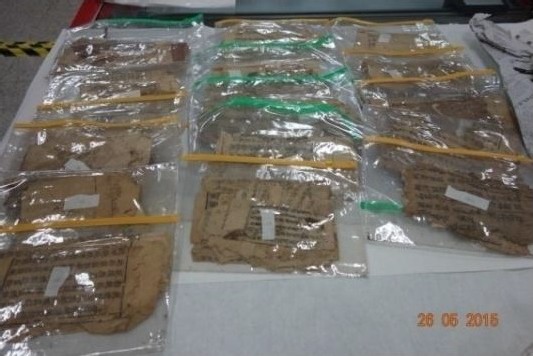
One of the Tangut texts acquired by the National Library of China in May 2015
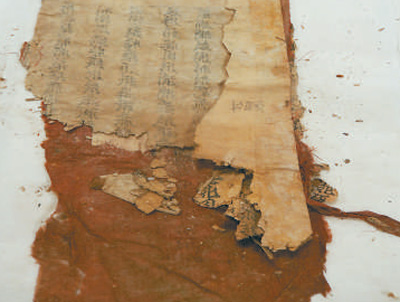
Addendum II: Auction Lists for Tangut Items
I have now created a comprehensive list of all Tangut textual items I have found for sale on auctions between 2012 and 2019 at this page. Direct links to the section of the page for individual auctions are listed below:
- Hosane March 2012 Auction (1 lot)
- Debao November 2014 Auction (9 lots)
- Qishi November 2016 Auction (2 lots)
- Taihe Jiacheng June 2017 Auction (1 lot)
- Sungari December 2017 Auction (21 lots)
- ZhongHongXin January 2018 Auction (1 lot)
- Qindao Rongde July 2018 Auction (1 lot)
- Sungari November 2018 Auction (2 lots)
- Rongbao December 2018 Auction (2 lots)
- Lianghan May 2019 Auction (1 lot)
- Taihe Jiacheng June 2019 Auction (13 lots)
- Poly June 2019 Auction (1 lot)
- Sungari June 2019 Auction (1 lot)
- Boguzhai June 2019 Auction (1 lot)
- Taihe Jiacheng October 2019 Auction (3 lots)
- Qindao Rongde November 2019 Auction (1 lot)
- Rongbao December 2019 Auction (1 lot)
- Boguzhai December 2019 Auction (1 lot)
Index of BabelStone Blog Posts
